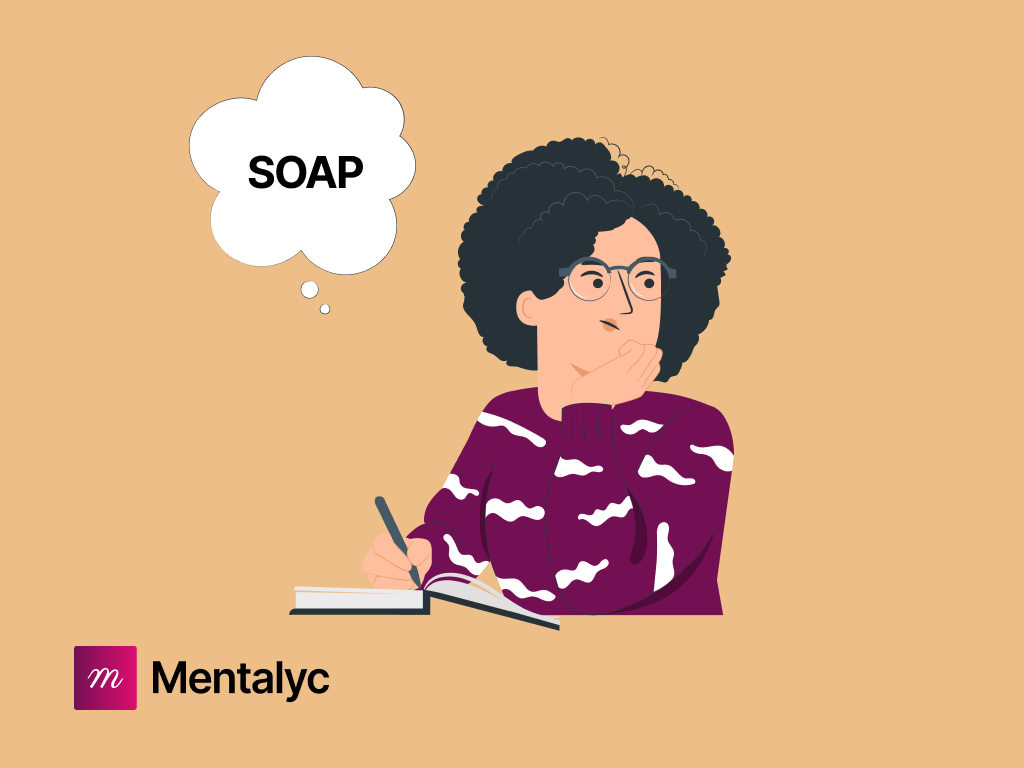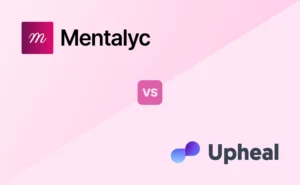Sometimes, one might have nightmares for no reason at all. At other times, your work might be spilling over into your dreams! You are astonished. Aren’t you? Let me explain: you are a mental health provider struggling with hundreds of patient cases.
You scribble down unorganized therapy notes, and you end up crashing with therapeutic standards and regulations, not to mention the huge efforts you wasted trying to remember clients’ information while deciphering useless notes. No worries, we understand how much you are going through; it is for this reason that this blog exists.
In this blog, we focus on one of the most essential tools for every clinician: SOAP Notes in Mental Health Counseling. These notes provide a structured framework that helps you capture client information clearly, accurately, and concisely. Mastering SOAP notes isn’t just about documentation—it’s about strengthening your clinical communication, ensuring continuity of care, and meeting professional standards with confidence.
We will also explore the ins and outs of SOAP notes for anxiety and depression and provide tips and best practices for creating well-organized and informative notes. So, let’s dive in!
SOAP Notes vs DAP Notes vs BIRP Notes
| Feature / Format | SOAP Notes | DAP Notes | BIRP Notes |
| Full Form | Subjective, Objective, Assessment, Plan | Data, Assessment, Plan | Behavior, Intervention, Response, Plan |
| Focus | Separates client reports, clinician observations, evaluation, and treatment plan | Combines all data into one section, followed by assessment and plan | Emphasizes behavior, therapeutic interventions, client’s response, and plan |
| Best For | Detailed clinical documentation, progress tracking, multi-provider settings | Quick, concise documentation with less detail | Behavioral health, progress monitoring, documenting interventions |
| Structure | 4 parts (S, O, A, P) | 3 parts (D, A, P) | 4 parts (B, I, R, P) |
| Advantages | Highly organized, supports insurance/legal compliance, improves communication | Simpler, faster to complete, easier for beginners | Tracks intervention effectiveness, highlights client’s response, good for therapy outcomes |
| Limitations | More time-consuming, requires strict separation of sections | Less detailed, may blur subjective vs objective info | May not capture broader context or long-term progress |
| Use in Mental Health | Widely used by psychiatrists, counselors, and therapists for SOAP notes in mental health counseling | Often used in community mental health or settings where quick notes are needed | Common in behavioral therapy, crisis intervention, and inpatient/outpatient programs |
SOAP Notes in Mental Health Practice
Although SOAP notes were initially developed for use in medical settings, they have become increasingly popular in mental health practice due to their clear and concise format. Mental health professionals can use a mental health SOAP note template for anxiety and depression, for example, to ensure they are effectively documenting the essential information needed for effective treatment planning and collaboration with other providers.
There are also other document formats that mental health professionals may encounter or choose to employ, such as DAP (Data, Assessment, Plan) and BIRP (Behavior, Intervention, Response, Plan) notes. Each format has its unique features and benefits, and the choice of which format to use often depends on personal preference and the specific needs of the clinician and their clients. For a more in-depth comparison of these documentation formats, check out our articles on DAP notes and BIRP notes.
What is a SOAP note and how it’s used in Counseling?
The SOAP writing method is a structured approach commonly used in medical and healthcare settings to document patient encounters and organize patient information. The acronym SOAP stands for Subjective, Objective, Assessment, and Plan, which represents different sections of the documentation. Interested in more efficient documentation options tailored to therapy? Here’s a helpful tool you should explore.
What is the SOAP writing method in Therapy Documentation?
The SOAP writing method is a structured approach commonly used in medical and healthcare settings to document patient encounters and organize patient information. The acronym SOAP stands for Subjective, Objective, Assessment, and Plan, which represents different sections of the documentation.
Interested in more efficient documentation options tailored to therapy?
That’s where Mentalyc can make a real difference. Instead of just offering a blank template, it actively helps therapists generate well-structured SOAP notes from session recordings. For example, it can take a client’s subjective report of anxiety (“I couldn’t sleep last night”) and place it neatly into the Subjective section, while observed behaviors and therapist impressions are organized into the Objective and Assessment. Finally, the Plan section is drafted in clear, clinical language that aligns with treatment goals and insurance requirements. This not only saves time but also ensures that your notes remain consistent, professional, and audit-ready. With Mentalyc, you’re not just writing faster—you’re documenting with greater clarity and accuracy.

The Four Parts of a SOAP Note in Mental Health Counseling
1. Subjective: Capturing Client-Reported Feelings and Experiences
The subjective component of a SOAP note focuses on the patient’s personal experiences, feelings, and concerns. This section should include details about the patient’s chief complaint, history of present illness, medical and family history, and any relevant social or environmental factors. When writing the subjective portion, it’s essential to use the patient’s words as much as possible to accurately convey their perspective. Understanding the components of SOAP note in mental health counseling helps ensure that this part captures the client’s lived experience effectively.
2. Objective: Documenting Observable Data in Therapy Sessions
The objective section of a SOAP note records observable data and factual information about the patient. This can include vital signs, physical examination findings, laboratory results, and any additional diagnostic data. In the context of mental health treatment, the objective section may also include details about the patient’s appearance, behavior, and speech patterns. Many practitioners find that using the SOAP format in counseling provides consistency and clarity in documenting these observations.
3. Assessment: Therapist Evaluation and Diagnosis in SOAP Notes
The assessment portion of a SOAP note is where the healthcare provider evaluates the information gathered during the subjective and objective sections. This section may include a diagnosis, a summary of the patient’s progress, and any potential risk factors or complications. In the case of anxiety and depression, the assessment might focus on the severity of symptoms, the effectiveness of current interventions, and any co-occurring conditions. To make this process easier, it’s helpful to structure SOAP notes for counseling in a way that highlights both challenges and progress.
4. Plan: Outlining Next Steps and Treatment Goals
The plan section outlines the next steps in the patient’s treatment, including any changes to their current interventions or the addition of new therapies. For anxiety and depression, this might involve adjustments to medications, the introduction of new coping strategies, or referrals to additional support services. This section plays a key role in SOAP notes in clinical documentation, as it ensures treatment plans are actionable, trackable, and easy to communicate across providers.
Are SOAP notes still used in Mental Health Counseling?
Yes, SOAP notes are still widely used in medical and healthcare settings. Despite the emergence of electronic health records (EHRs) and other digital documentation methods, the SOAP format remains a popular and effective way to document patient encounters.
SOAP Note Examples for Mental Health
Anxiety SOAP Note Example
Subjective:
Chief complaint: Patient reports feeling “constantly on edge” and experiencing panic attacks.
History of present illness: Patient describes a 6-month history of increasing anxiety symptoms.
Relevant personal and social history: Recent job loss, family history of anxiety disorders.
Objective:
Appearance: Anxious, fidgety, avoids eye contact.
Behavior: Rapid speech, difficulty sitting still.
Psychiatric symptoms: Reports excessive worry, restlessness, irritability, and sleep disturbances.
Assessment:
Diagnosis: Generalized Anxiety Disorder (GAD).
Progress: Patient has been attending weekly therapy sessions for 2 months with some improvement in symptoms.
Plan:
Continue weekly therapy sessions focused on cognitive-behavioral techniques.
Consider medication evaluation if symptoms do not continue to improve.
Encourage patient to engage in relaxation exercises and regular physical activity.
Depression SOAP Note Example
Subjective:
Chief complaint: Patient reports feeling “hopeless” and lacking motivation.
History of present illness: Patient describes a 3-month history of depressive symptoms.
Relevant personal and social history: Recent relationship breakup, social isolation, family history of depression.
Objective:
Appearance: Disheveled, poor eye contact, flat affect.
Behavior: Slow speech, minimal spontaneous movement.
Psychiatric symptoms: Reports persistent sadness, loss of interest in activities, fatigue, and difficulty concentrating.
Assessment:
Diagnosis: Major Depressive Disorder (MDD).
Progress: Patient has been attending bi-weekly therapy sessions for 1 month with minimal improvement in symptoms.
Plan:
Increase therapy sessions to weekly and incorporate cognitive-behavioral techniques.
Schedule a medication evaluation with a psychiatrist.
Encourage patient to engage in social activities and regular physical activity.
How to Write Effective SOAP Notes for Therapy Sessions
Writing well-organized and informative SOAP notes for counseling is crucial for effective treatment planning and communication between healthcare providers. Here are some tips to write a high-quality SOAP note:
1. Be concise and specific: Avoid using vague language or unnecessary details. Instead, focus on providing accurate and relevant information about the patient’s condition and treatment plan.
2. Use the patient’s words: Whenever possible, use direct quotes from the patient to convey their subjective experiences and feelings accurately.
3. Separate subjective and objective information: Make a clear distinction between the patient’s self-reported symptoms (subjective) and the observable data gathered by the healthcare provider (objective).
4. Update the assessment and plan sections regularly: As the patient’s condition changes, make sure to update the assessment and plan sections to reflect their current status and treatment goals. This is one of the key principles of writing SOAP notes effectively.
How long should a SOAP note be? (Length and Frequency)
The length of a SOAP therapy note will vary depending on the complexity of the patient’s condition and the amount of information that needs to be documented. However, it is essential to keep SOAP notes as concise and clear as possible, including only necessary information.
The frequency of writing SOAP therapy notes depends on the specific requirements of the practice or setting in which you work. However, it is generally recommended to write SOAP notes after each session to ensure timely and accurate documentation.
By writing SOAP notes immediately after a session, you capture the most relevant and accurate information while it is fresh in your mind. This helps to ensure the accuracy of your notes and minimizes the risk of forgetting important details. It also allows you to track the client’s progress over time and make informed decisions about their treatment plan. Consistently updating SOAP notes for progress tracking helps clinicians evaluate outcomes and adjust interventions when necessary.
Writing SOAP notes after each session also promotes consistency in documentation, which is important for effective communication among healthcare professionals involved in the client’s care. It provides a standardized format for recording information, making it easier for other professionals to understand the client’s history, progress, and treatment goals.
In some cases, there may be exceptions to writing SOAP notes after every session, such as when multiple sessions occur within a short period or when the sessions are part of a continuous treatment plan. In such situations, it may be appropriate to summarize multiple sessions in a single SOAP note, highlighting the key information and progress made during that period.
Ultimately, the frequency of writing SOAP therapy notes should align with the specific needs and requirements of your practice or setting and any legal and regulatory guidelines governing documentation in your jurisdiction.
Organizing and Structuring SOAP Notes in Mental Health Counseling
To effectively organize SOAP notes, follow these guidelines:
1. Use a consistent format: Adhering to the standard SOAP format (Subjective, Objective, Assessment, Plan) ensures that your notes are easy to read and understand.
2. Break information into digestible sections: Divide the content into clear sections and use subheadings to further organize the information.
3. Use bullet points and numbered lists: Presenting key points in a visually appealing manner can make your notes easier to read and reference.
4. Update notes regularly: Keep your SOAP notes up-to-date by regularly updating the assessment and plan sections to reflect the patient’s current status and treatment goals.
5. Incorporate technology: Consider using practice management software or other digital tools to help you manage and organize your SOAP notes. Mentalyc makes writing SOAP notes feel simple and stress-free. With ready-to-use templates and AI that helps draft your notes, everything is neatly organized. You’ll spend less time worrying about paperwork and more time focusing on your clients.
What are SMART goals in SOAP notes?
SMART goals (Specific, Measurable, Achievable, Relevant, and Time-bound) can be a valuable addition to SOAP therapy notes. They can help healthcare professionals establish clear, objective, and realistic treatment goals for their patients, providing a framework for tracking progress and adjusting treatment plans as needed.
By integrating SMART goals in SOAP notes, clinicians can effectively measure patient progress, identify areas for improvement, and ensure that the treatment plan aligns with the patient’s unique needs and desires.
When writing the Plan section of your SOAP notes, consider using the SMART goal framework to outline specific objectives for your clients’ treatment. This can help to clarify expectations, promote accountability, and facilitate communication between you, your clients, and any other professionals involved in their care. Specific: Reduce the frequency and intensity of panic attacks.
Measurable: Decrease the number of panic attacks from 4 per week to 1 per week.
Achievable: Utilize cognitive-behavioral techniques and relaxation exercises to manage anxiety.
Relevant: Addressing panic attacks will improve the patient’s overall mental health and quality of life.
Time-bound: Achieve this goal within 3 months of starting treatment.
Are SOAP notes written after every session?
Yes, SOAP notes are typically written after every session or patient encounter to document relevant information about the patient’s condition, assessment, and treatment plan.

Pros and Cons of SOAP Notes
While SOAP therapy notes provide an organized and structured approach to documentation, there are some limitations.
Pros
1. Standardized format: The structured format of SOAP notes allows healthcare providers to quickly and easily access pertinent information about a patient’s condition and treatment plan.
2. Improved communication: SOAP notes facilitate clear and concise communication between healthcare providers, ensuring continuity of care for the patient.
3. Comprehensive documentation: SOAP notes provide a thorough and organized record of a patient’s progress, which can be essential for legal and insurance purposes.
Cons
1. Time-consuming: Writing detailed and organized SOAP notes can be time-consuming, particularly for busy healthcare professionals.
2. Inconsistent quality: The quality of SOAP notes can vary significantly between providers, which can lead to confusion and miscommunication.
3. Limited focus: Some critics argue that SOAP notes may not adequately capture the complexities of mental health treatment, as they typically focus on a specific problem or diagnosis.
Despite these limitations, SOAP therapy notes remain a valuable tool for healthcare professionals in providing consistent, clear, and organized documentation of patient care.
This video tutorial will teach you how to write effective SOAP notes.
The Bottom Line
SOAP therapy notes are a valuable tool for healthcare professionals in documenting patient care. By adhering to best practices, such as being clear, concise, accurate, and timely, clinicians can optimize the effectiveness of SOAP notes in facilitating communication and continuity of care. Mastering the art of SOAP note writing, utilizing templates, and incorporating best practices will enhance the quality of patient care and improve communication among healthcare providers. Mental health professionals, in particular, can benefit from mastering SOAP notes for psychotherapy when working with patients experiencing anxiety and depression. By following the components, templates, and guidelines outlined in this comprehensive guide, healthcare professionals can ensure that their SOAP notes are effective, contributing to the overall quality of care provided to patients.
Last but not least
You are not alone! We are here to transform the note-taking process into growth opportunities. With enough effort and time, you will become proficient in drafting vital psycho-therapeutic documentation. And keep in mind that, as with every skill you need to master in this life, practice makes perfect!
An App for Psychotherapists
Mentalyc is a note-taking tool that uses AI to write notes. With Mentalyc all your note-taking needs are fully automated and your notes are sure to be consistently accurate and well-written. Mentalyc’s automated SOAP notes help you save time, reduce compliance risk, and allow you to focus fully on your client during sessions.
Mentalyc now offers all kinds of notes. It is among the most trusted HIPAA-compliant note-taking tools, making it a secure option for protecting client confidentiality. The platform also provides therapy note templates for clinicians, allowing customization to meet different therapeutic approaches and documentation standards. To learn more, register today for a free trial.
See how clinicians describe their experiences with Mentalyc in their own words:
Why other mental health professionals love Mentalyc

“By the end of the day, usually by the end of the session, I have my documentation done. I have a thorough, comprehensive note … It’s just saving me hours every week.”
CDCII

“I really like that the treatment plans make sense, and they’re based on the case notes I’ve been entering.”
Therapist

“Do yourself a favor, make your life easier. Use the tools that are readily available … I found Mentalyc to be one of the best tools that I’ve ever used.”
Licensed Marriage and Family Therapist

“It immediately changed my quality of life, personally and professionally. I went from 3–4 hours a week of notes to 1 hour at most … that alone is invaluable personally and professionally.”
Owner/Independently Licensed Marriage & Family Therapist (IMFT)
Below is an example of a SOAP note written by Mentalyc SOAP Note Generator:
Subjective:
The client presented with ongoing work-related stress, feelings of being overworked and tired, and uncertainty about his career path. He expressed a desire for a career change but felt unsure which direction to pursue, considering options such as human resources, real estate, and therapy. He reported experiencing anxiety and impatience, attributing these feelings to work stress and physical exhaustion. The client also mentioned an upcoming cardiologist appointment related to a previous heart procedure and his preference to see the original specialist. Additionally, he expressed self-pity due to overworking and neglecting self-care. He stated, “I feel like I have no life. It’s like a working machine.
Objective:
A clinical interview was conducted to explore the client’s work stress, career concerns, and emotional state, and to assess progress and identify next steps. No risks or safety concerns were identified.
Assessment:
The client actively engaged in therapy, openly discussing his challenges and feelings, indicating a positive therapeutic alliance. His work-related stress is significantly impacting his energy levels, patience, and overall quality of life. He is struggling with career decision-making and feels trapped in his current job. The client’s anxiety and impatience, related to work stress and physical exhaustion, appear persistent with no significant change since the last session, impacting his family interactions and contributing to his overall feeling of being overwhelmed.
Plan:
The client will take a personality test and reflect on the results. In the next session, the test results will be discussed, potential career paths will be explored based on those results, and coping strategies for managing work stress and anxiety will be further developed. Continued therapy will address work stress, career uncertainty, and emotional regulation. Short-term objectives include identifying potential career paths, developing coping mechanisms for stress and anxiety, and improving overall well-being.
Mentalyc AI Note-Taking Tool Plans & Pricing
| Plan | Price | Key Features |
| 14-Day Free Trial | $0 | 14 days of full PROaccess, including 15notes—no credit cardrequired. |
| Mini | USD 14.99 /month | Record in-personsessions, upload audiofiles, use voice-to-text,or type notes directly, etc |
| Basic | USD 29.99 /month | Everything in Mini, plus:Alliance Genie™ NEW!(limited access), Smart TP™ |
| Pro | USD 59.99 /month | EMDR, Play andPsychiatry modalities,100+ custom templatesincld. BIRP, PIRP,GIRP, PIE, and SIRP,Auto-computed CPTcodes |
| Super | USD 99.99 /month | Everything in Pro, plus:Group therapy notes foreach group member,Priority onboarding andsupport |





